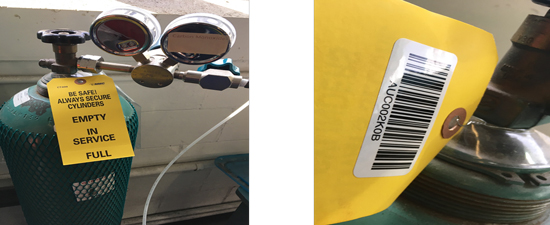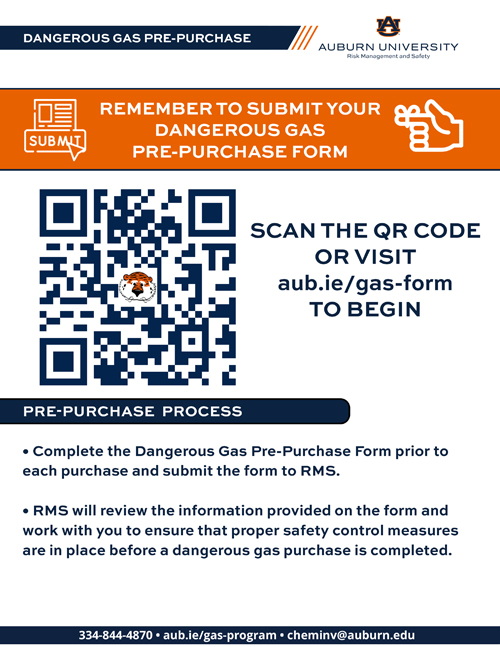
The purpose of the Dangerous Gas Program is to provide guidelines that will promote safe and healthy environment for researchers, building occupants, or emergency responders (exposure or gas leak events) by establishing minimum standards and safe practices that will reduce the likelihood of accidental release of dangerous gas.
Gases with any of the following characteristics will fall under the Dangerous Gas Program:
- Pyrophoric (self-igniting) or dangerously reactive gases
- Gases with a National Fire Protection Association (NFPA) health hazard rating of 3 or 4
- Gases with an NFPA health hazard rating of 2 and poor physiological warning properties
- Extremely low occupational exposure limits in the absence of an NFPA health rating
Dangerous gas purchase requires pre-purchase notification to Risk Management and Safety (RMS). Toxic and dangerously reactive gases should only be purchased from vendors agreeing to take back empty gas cylinders.
The Dangerous Gas Pre-Purchase Notification Form (also embedded below) will provide preliminary information to RMS who will determine if appropriate safety control measures are in place before acquiring dangerous gases.
Pre-Purchase Process
- Complete the Dangerous Gas Pre-Purchase Notification Form prior to each purchase and submit the form to RMS. You may use the embedded form below or visit aub.ie/gas-form .
- RMS will review the information provided on the form and then contact you to approve the purchase or
- RMS will review the information provided on the form and work with you to ensure that proper safety control measures are in place before a dangerous gas purchase is completed.
Reorders of similar gases (type, concentration, and quantity) will not require additional pre-purchase notification to Risk Management and Safety (RMS)
Cylinders containing dangerous gases should be inventoried upon receipt. Hanging tags with barcodes will be utilized to simplify verification through our online hazardous chemicals management system (Chematix). The hangtag should be attached to the cylinder as shown below. The same hangtag can be used if replacing similar gas and quantities.

- RMS, together with PIs, will conduct a hazard evaluation before dangerous gases are used. The evaluation will cover the risks posed by dangerous gases, process safety, and gas monitoring needs.
- Fume hoods, ventilated gas cabinets or other specialty local ventilation exhaust systems / enclosures are required in labs where dangerous gases are stored and manipulated.
- Process-specific operating procedures should include safety apparatus features e.g., restricted flow orifice (RFO), excess flow valves, emergency shutoff valves etc.
- RMS in collaboration with PIs will determine the need and review gas monitoring specifications before it is purchased. This is to evaluate suitable gas monitoring systems, define alarm set points, specify calibration requirements, and have uniform alarm notifications and responses.
- Gas monitoring systems should be designed to interface with the building fire alarm notification systems if possible. PIs should have alarm notification and response procedures documented. Contact names and numbers must be provided for on and off hour responses.
Resources:
Examples of Dangerous Gases
Dangerous Gas Pre-Purchase Notification Form
Dangerous Gas Guidance Document
Safe Handling of Cryogenic Liquids Training (BioRAFT)
Working with Dangerous Gases Training (BioRAFT)
Upcoming Events
| View All Events |



